ART IN THE THERAPEUTIC CLASSROOM
Freud's concept of the dynamic unconscious means that everything we do or say has its significant unconscious aspects. In intensive psychoanalysis this significance is uncovered by the technique of free association, a method difficult to use with children since it involves the psychoanalytic couch. Instead, the child may be given access to play and art materials which in their use often provoke chains of free association similar to the adult's verbalizations, and are susceptible to the same running commentary of interpretation.
Not that the teacher in the therapeutic classroom will attempt interpretations, even although at times the significance of what the child does may be quite transparent. Nor will the child's work ever be censored. In stead teachers will rely on the cathartic potential of the activity and on the hope that the initial dramatic, "literary" impulse may carry over into a preoccupation with formal values.
Documentation of the therapeutic significance of purely formal concerns has come to us in the last ten years particularly from the followers of Ihe late Melanie Klein. Kleinians like Hanna Segal and the English critic Adrian Stokes (all in the Freudian current) have shown how closely connected to our unconscious mechanisms are the making processes of the visual artist; they believe that the very arranging and erasing, juxtaposing and reshaping that the artist does are themselves means of increasing his mental resilience and ours. Kleinians, indeed, have pioneered territory of which Freud himself, with his neglect of the consideration of abstract form, was barely aware.
In this light, the aim of art teaching becomes making the forming experience available to every student. It is characteristic of the disturbed child, however, that his road to this end is undermined by a distorted view of the world and the uncontrollable nature of his associated fantasies. The meaning of what he creates is so loaded that he will often destroy what he has done, or come to a sudden stop, or he may be productive only around one comparatively safe theme - and that in a mechanical, repetitive way.
When a child·s creativity breaks down, an expedient but narrow solution may lie in introducing him to nonfigurative processes which can perhaps bypass the problems inherent in figuration. The alternative is a broadly based therapeutic program which does not hurry the child towards "success" but rather sees art as a means and index of the child's therapeutic progress. The following is an example of how art functioned in this respect in the case of a moderately disturbed boy of 13.
Tony's father deserted soon after his birth and he was adopted by his maternal grandparents while his mother remarried and produced a quite separate family. However, the maternal grandfather died and not long afterwards the grandmother became a semi-invalid. In this situation Tony remained infantile -- his co-ordination was still that of a five-year-old, his school progress was crippled and he showed excessive fearfulness. At 13 he remained still involved with the classical Oedipus situation, which most children resolve in some way before they enter kindergarten. You might even say that, like Oedipus, Tony had "killed" his "father" and "married" his "mother," and like Oedipus had mutilated himself — by remaining infantile.
This "self-mutilation" is seen throughout one of his first essays (see illustration) to occur every time Tony has an impulse to assert himself. The essay, on cars, begins as an objective discussion, but the omnipresent nature of Tony's problem is soon apparent.
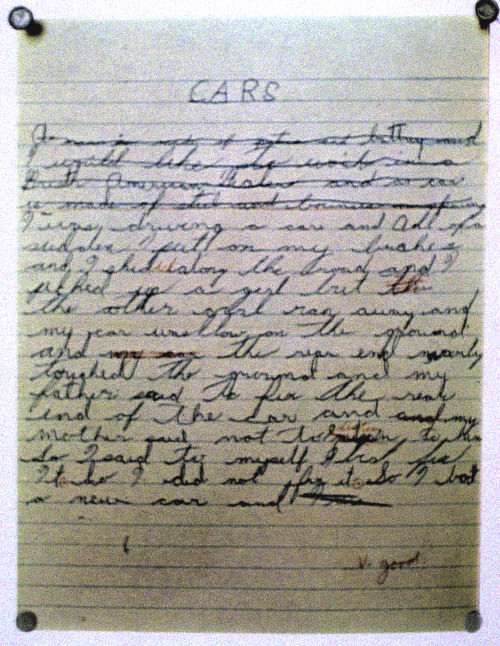
The subject of cars is quickly associated to feelings of potency, and the objective level of the essay is left behind. Tony wants to feel potent (skids to a halt and picks up a girl) but cannot permit the feeling to last (the car breaks down). Again he wants to feel effective, even recruiting the Oedipal father (my father said fix It), but again comes the compulsive feeling of impotence (my mother said not to listen). Yet again he struggles for masculine effectiveness (I said to myself I best fix it), but again he fails (so I did not fix it): and finally he shelves the whole problem (so I bought a new car). The tired quality of Tony's handwriting reflects exactly the quality of helplessness that invades the essay.
A therapeutic classroom provided Tony with the first adult male to enter his life regularly since his pre-school days, and in the permissive atmosphere he at once began to use the teacher to resolve the Oedipal problem left with him by the death of his grandfather. He began to show towards the teacher the rivalry and hostility that the four-year-old typically feels for his father, testing these feelings out, so to speak, to see if this substitute father would also die. At the same time he voiced his fear of the "father's" possible castratory retaliation, in actual genital terms — asking on one occasion if there were hospitals where the male attribute was removed. Such a question, although couched so specifically, may be seen as asking the "father's" approval of the boy's need to grow up. Tony verbalized this question only once, but it was asked at least twice more through the symbolism of the images illustrated below.
Images …
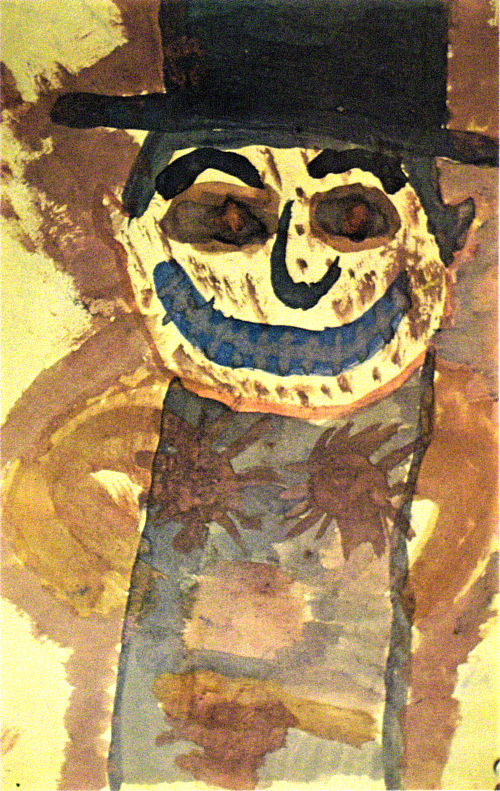
1) The picture of a tough, unshaven man was at first given genitalia, but, although the teacher viewed this without comment, Tony not unnaturally failed to sustain his assertiveness and painted them out, symbolizing his ambivalence by adding breasts, that he also painted over.
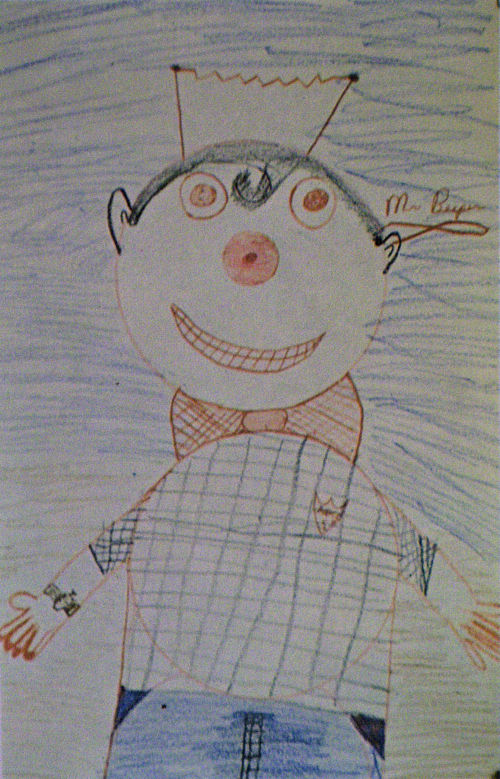
2) The picture of Mr Beeper originates from random playing with a pair of compasses but also ends in a symbolic demand for reassurance over castration fears, as can be seen. After this there are no more such frank references.
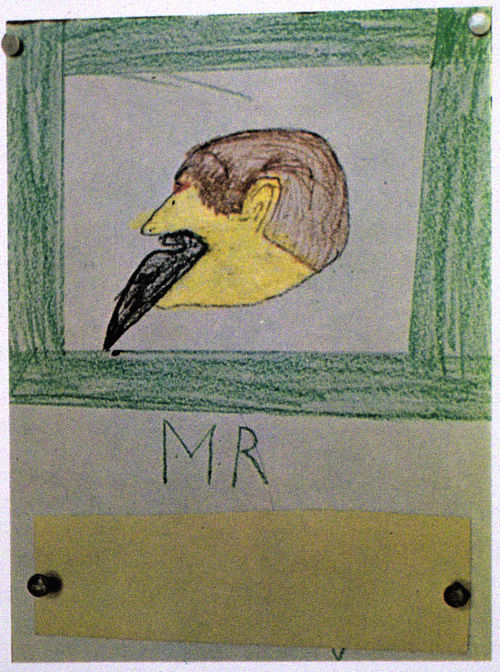
3) Tony's ambivalence about growing up seems to recede and a more confident acceptance of the "father" is signified by the portrait of the teacher, who, although clean shaven in reality, is given symbolic potency by the addition of a beard.
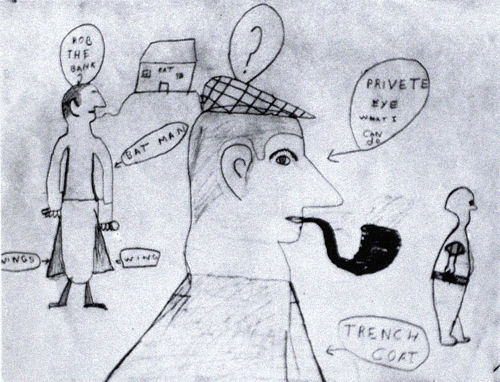
4) The picture of Bat Man also includes a symbolically important pipe, and is even realized in a more mature style. These later pictures seem to suggest that Tony has found a tentative (and typical) road to maturity, by beginning to identify with the teacher "father" and with popular heroes of the media. They indicate that the wider therapeutic program, in which art has had an important share, is beginning to bear fruit.
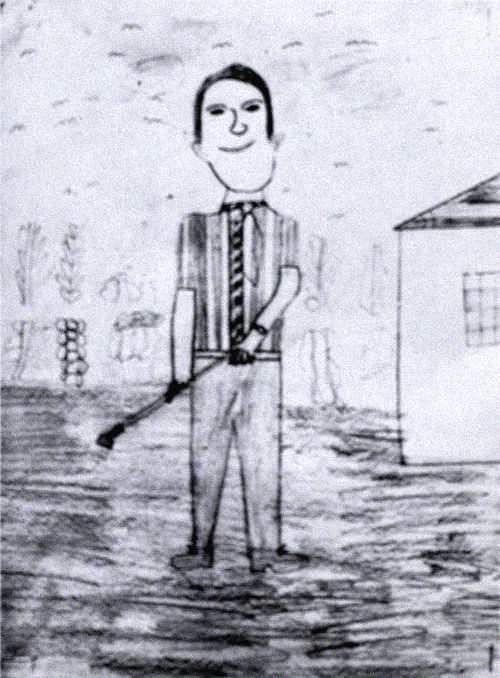
5) Now, after about three years in the therapeutic classroom, at least some of his fears have ceased to intrude and, free of them, he shows an astonishing creative potential in this picture of a man working his garden among burgeoning Brussels sprouts. In this drawing, without being aware of it, he has actually made an allegory of his own situation and, in fact, a self-portrait -- by emphasizing the gardener’s chin. Students of haptic psychology will know that such self portraits occur quite frequently among children and even among some adults: when they are asked to draw, or model in clay, an “average” human face, some, at least, will inadvertently create an image of themselves.
